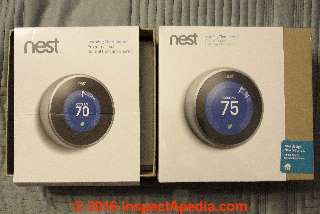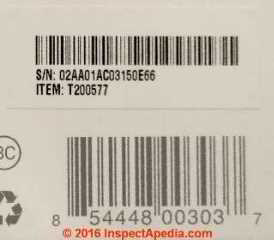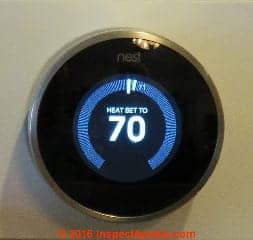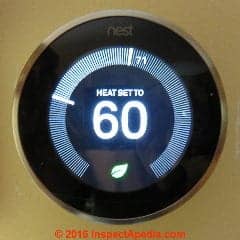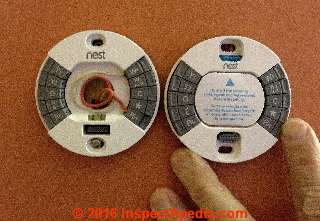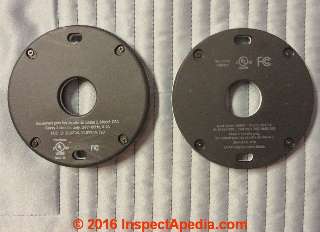 Nest™ Learning Thermostats: Nest 2 versus Nest 3
Nest™ Learning Thermostats: Nest 2 versus Nest 3
Photos & Specifications Compare the Nest™ 2 vs Nest™ 3 Learning Thermostats
- POST a QUESTION or COMMENT about Nest™ Room Thermostats for Air Conditioners & Heating Systems or heat pumps: thermostat operation, wiring, adjustment & repair procedures
Nest 2 compared with Nest 3 Learning Thermostats:
What's the difference between a Nest 2 and Nest 3 thermostat? How to tell the difference between a Nest 2 and Nest 3 thermostat? How much difference is there really between a Nest 2 and Nest 3 thermostat? Should you change out a Nest 2 for a Nest 3? At page top: we compare the mounting base plate of the Nest 2 and Nest 3 learning thermostats. The Nest 3 or third generation Nest is on the right.
This article series describes the Nest™ learning thermostat product series, giving photo-illustrated detailed guides for the mounting, wiring, set-up and use of Nest thermostats. These articles explain selection, installation, use, setting, and adjustment of Nest Learning Thermostats - heating or cooling system room thermostats or "wall thermostats".
InspectAPedia tolerates no conflicts of interest. We have no relationship with advertisers, products, or services discussed at this website.
- Daniel Friedman, Publisher/Editor/Author - See WHO ARE WE?
Comparing the Nest™ 2 with the Nest™ 3 Learning Thermostat: What's the Difference?
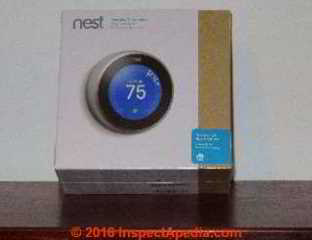 In the course of installing and writing about Nest learning thermostats we installed quite a few Nest devices and had just a few surprises.
In the course of installing and writing about Nest learning thermostats we installed quite a few Nest devices and had just a few surprises.
One surprise was noticing, on return from a Best Buy store with a new Nest learning thermostat that the "new" model looked rather different from the Nest 3's that we'd already installed. A closer look discovered we'd been sold a Nest 2 thermostat at a slightly lower price.
If you were set upon buying the "latest" Nest thermostat in 2015 you might come home from the store with an older-model by mistake unless you take some care to examine the packaging and to ask the right questions.
Some of the store clerks we interviewed did not seem to know that their store was stocking and displaying two different Nest thermostat models.
[Click to enlarge any image]
Later as the older Nest 2 learning thermostat store stocks are sold-down, this mix up may become unlikely.
At above/left is a Nest 3 learning thermostat still in the box, fresh from the supplier. A closer look at that little blue label on the package at lower notes that this sticker indicates "New Design. New Features". But "new" compared to what? An inexperienced Nest thermostat buyer might not know? We found nothing on this package stating in plain English: Nest 3 Thermostat.
Lets start by comparing the Nest thermostat packaging to help you tell which Nest thermostat you're buying if you didn't ask the store clerk or if the clerk just arrived with the latest rain. We will follow packaging and labeling differences with a list of Nest thermostat feature differences that will help you decide how much you care about the differences in features of these two thermostat models.
Nest 2 vs Nest 3 Packaging & Bar Codes: how to tell which thermostat you have found in the store
[Click to enlarge any image]
Nothing Nest learning thermostat packaging explicitly gives the generation number or Nest number on the package, but you can still tell which product is which.
The second generation Nest 2 thermostat, at left in our photo above, shows a temperature setting of 70 deg F.
The Nest 3 thermostat (at right in the photo) is set to 75 deg F. And the "newer" Nest 3 also sports a little blue label indicating "New Design. New Features".
Above our photo illustrates the bar codes and serial numbers of a Nest 2 (first photo) and Nest 3 learning thermostat (second photo). The Nest model was encoded in the package bar-code and could be examined by the register clerk while ringing-up the sale. But nobody mentioned that to our Nest thermostat buyer.
The Nest 2 Thermostat uses Item No.T200577 while the Nest 3 Thermostat uses Item No. T3007ES. The bar codes differ and of course portions of the serial number also indicate the thermostat's model.
Nest did list some feature differences between the Nest 2 and Nest 3 such as overall dimensions (the Nest 3 is a bit larger) and display size (the Nest 3 display is larger than the Nest 2) and notes that the sensor used by the Nest 3 to determine that people are present (or moving) near the thermostat can sense at a greater distance.
Other feature differences between the two thermostats are not emphasized. Considering that many of the features and controls of both thermostats reside in the device software (programming) and that Nest can update the software in its Nest 2 or Nest 3 thermostats over an Internet connection, the practical differences between the two models may be principally those of display size and people sensing range that we'll describe below.
Nest 2 vs Nest 3 Overall Size & Display Size
Above, our first photo illustrates a Nest 2 learning thermostat installed in a Chicago home showing Heat set to 70 degrees F. Or second photograph illustrates a Nest 3 learning thermostat installed in a New York home and set to 60 degrees F.
The Nest 2 is 3.2" in overall diameter and 1.26" thick. The Nest 3 is 3.3" in diameter and 1.21" thick. The difference in projection of the thermostat out from the wall will not be significant for most users. But let's look more closely at the display size. That slight change in overall diameter of the thermostat is not the whole story.
The Nest 3 display screen itself occupies more space in the physical device - notice that the black surrounding the Nest 3 display is thinner than the black surrounding the display of the Nest 2 thermostat shown in our photos above. The Nest 3 thermostat actual display area is 40% larger than the Nest 2.
We note below that its resolution is also greater than the Nest 2. Our photographs of the two thermostats are roughly correct but not precisely to scale.
Nest 2 vs. Nest 3 Display Connectors & Level Indicators
Parts cannot be exchanged between a Nest 2 and Nest 3 thermostat. If your rowdy neighbor tossed a hardball that has smashed your Nest 2 thermostat, you'll need to buy a whole new Nest 2 or you'll buy a whole new Nest 3. What you cannot do is buy a Nest 3 display and plug it into the Nest 2 wall plate. Why not? The connectors and wall plate size don't match.
[Click to enlarge any image] Take a closer look at the photo of the two Nest thermostat wall plates shown just above.
At left in the photograph is a Nest 2 second generation wall plate: the diameter is a bit smaller than the Nest 3 (at right in the same photo), the level is at the wall plate bottom rather than the top as shown on the Nest 3 wall plate, and also the connector plug changed from rectangular (Nest 2) to ovate (Nest 3).
Above we see the back surface of the two wall mounting plates for Nest thermostats. The Nest 2 is at left and Nest 3 at right in this photograph.
Above you see the back sides of two Nest display units.
At left in the photo is the Nest 2 while at right in the photo is the Nest 3. The Nest 3 connector at the display bottom changed to ovate from rectangular. You might also notice the slightly larger overall diameter of the nest 3 in this picture.
Other Nest 2 vs Nest 3 Feature Differences
Aside from overall size and display size that we compared for the Nest 2 and Nest 3 thermostats above, here are other feature differences between the two models:
Nest Thermostat Display Resolution
- Nest 2: 320 x 320 pixels, 183 ppi - this feature won't be affected by software updates
- Nest 3: 480 x 480 pixels, 229 ppi - this feature also wont' change but gives a larger, sharper display image than the Nest 1 or Nest 2 thermostats.
Nest Thermostat Wireless network support:
- The Nest 2 operates on the 802.11 b/g/n network at 2.4 GHz
- The Nest 3 operates on the 802.11 b/g/n network at 2.4 GHz but it can also operate at 802.11 a/b/g/n network protocols at 5 GHz. If your router supports the higher speed you may find less interference and greater range, thus greater online reliability with the Nest 3 than you found with the Nest 2.
Nest Thermostat Near-Field / Far-Field Sensor Ranges
The Nest 2 uses a near-field sensor with about a 36-inch range to notice motion near the thermostat: that's how the thermostat might know that the area whose heating or cooling are controlled by the thermostat is occupied. And that's how a thermostat can learn your building occupancy patterns and might automagically adjust the building's heating or cooling settings to reduce your energy cost.
The Nest 3 thermostat uses a more distant "far-field" sensor that Nest calls Fasrsight. When you walk near the thermostat the display activates to allow you to read the temperature and thermostat settings from a distance - consonant with the increase in display size and resolution for the Nest 3.
In addition, of course, this greater distance sensitivity (about 20 feet) also improves the thermostat's ability to know when the building is occupied or perhaps empty.
The Nest 3, using Nest's Family Accounts and Home/Away Assist feature can also learn to recognize the presence of building occupants' or family members' cellphones as another means to boost the thermostat's ability to set "Home" or "Away" status for the thermostat.
A similar feature works with Nest security cameras too. We found using the Home/Away feature particularly helpful to combine heating cost savings with an ability to keep an eye on unoccupied buildings to reduce the risk of freeze-damage in winter weather.
Rather than arriving home to a very cold house whose smart thermostats don't know you're in town until you walk in the door, use your Nest Account or Nest Family Account to change the building status from AWAY to HOME to automatically turn up the heat a while before you arrive at home.
Nest Thermostat Device Memory:
Both the Nest 2 and Nest 3 sport an internal storage of 512MB.
Nest Thermostat List Price:
We paid $50. more for our Nest 3 ($250. USD) at Best Buy in Poughkeepsie, NY than we did for a Nest 2 in the same store in the same month in 2015.
"The Nest Learning Thermostat" is an electronic device that can control room temperatures and possibly other components connected to or installed as part of a home automation system.
...
Continue reading at NEST LEARNING THERMOSTATS - topic home, or select a topic from the closely-related articles below, or see the complete ARTICLE INDEX.
Or see these
Recommended Articles
- NEST LEARNING THERMOSTATS - home
- HUMIDITY RESPONSE, NEST THERMOSTATS
- Nest C-WIRE WASSERSTEIN C-WIRE KIT INSTALLATION DETAILS
- Nest C-WIRE KIT FAILURE, DEFECTIVE AC ADAPTER TEST
- NEST THERMOSTAT INSTALLATION & WIRING
- NEST THERMOSTAT SET-UP & PROGRAMMING
- NEST THERMOSTAT SET-UP COOL vs HEAT
- NEST 2 vs NEST 3 THERMOSTATS
- NEST THERMOSTAT WIRING INSTRUCTIONS for use with their Energy Kinetics 2000 MANAGER [PDF]
Suggested citation for this web page
NEST 2 vs NEST 3 THERMOSTATS at InspectApedia.com - online encyclopedia of building & environmental inspection, testing, diagnosis, repair, & problem prevention advice.
Or see this
INDEX to RELATED ARTICLES: ARTICLE INDEX to HVAC THERMOSTATS
Or use the SEARCH BOX found below to Ask a Question or Search InspectApedia
Ask a Question or Search InspectApedia
Try the search box just below, or if you prefer, post a question or comment in the Comments box below and we will respond promptly.
Search the InspectApedia website
Note: appearance of your Comment below may be delayed: if your comment contains an image, photograph, web link, or text that looks to the software as if it might be a web link, your posting will appear after it has been approved by a moderator. Apologies for the delay.
Only one image can be added per comment but you can post as many comments, and therefore images, as you like.
You will not receive a notification when a response to your question has been posted.
Please bookmark this page to make it easy for you to check back for our response.
IF above you see "Comment Form is loading comments..." then COMMENT BOX - countable.ca / bawkbox.com IS NOT WORKING.
In any case you are welcome to send an email directly to us at InspectApedia.com at editor@inspectApedia.com
We'll reply to you directly. Please help us help you by noting, in your email, the URL of the InspectApedia page where you wanted to comment.
Citations & References
In addition to any citations in the article above, a full list is available on request.
- [2] "The Nest Learning Thermostat", Nest Thermostat, 900 Hansen Way Palo Alto, CA 94304, Tel: 855-4MY-NEST, Email: info@nest.com, website http://www.nest.com/, retrieved 1/24/2013.
- [14] "Residential Hydronic (circulating hot water) Heating Systems", Instructional Technologies Institute, Inc., 145 "D" Grassy Plain St., Bethel, CT 06801 800/227-1663 [home inspection training material] 1987
- [15] "Warm Air Heating Systems". Instructional Technologies Institute, Inc., 145 "D" Grassy Plain St., Bethel, CT 06801 800/227-1663 [home inspection training material] 1987
- [16] Heating, Ventilating, and Air Conditioning Volume I, Heating Fundamentals,
- [17] Boilers, Boiler Conversions, James E. Brumbaugh, ISBN 0-672-23389-4 (v. 1) Volume II, Oil, Gas, and Coal Burners, Controls, Ducts, Piping, Valves, James E. Brumbaugh, ISBN 0-672-23390-7 (v. 2) Volume III, Radiant Heating, Water Heaters, Ventilation, Air Conditioning, Heat Pumps, Air Cleaners, James E. Brumbaugh, ISBN 0-672-23383-5 (v. 3) or ISBN 0-672-23380-0 (set) Special Sales Director, Macmillan Publishing Co., 866 Third Ave., New York, NY 10022. Macmillan Publishing Co., NY
- Our recommended books about building & mechanical systems design, inspection, problem diagnosis, and repair, and about indoor environment and IAQ testing, diagnosis, and cleanup are at the InspectAPedia Bookstore. Also see our Book Reviews - InspectAPedia.
- In addition to citations & references found in this article, see the research citations given at the end of the related articles found at our suggested
CONTINUE READING or RECOMMENDED ARTICLES.
- Carson, Dunlop & Associates Ltd., 120 Carlton Street Suite 407, Toronto ON M5A 4K2. Tel: (416) 964-9415 1-800-268-7070 Email: info@carsondunlop.com. Alan Carson is a past president of ASHI, the American Society of Home Inspectors.
Thanks to Alan Carson and Bob Dunlop, for permission for InspectAPedia to use text excerpts from The HOME REFERENCE BOOK - the Encyclopedia of Homes and to use illustrations from The ILLUSTRATED HOME .
Carson Dunlop Associates provides extensive home inspection education and report writing material. In gratitude we provide links to tsome Carson Dunlop Associates products and services.


